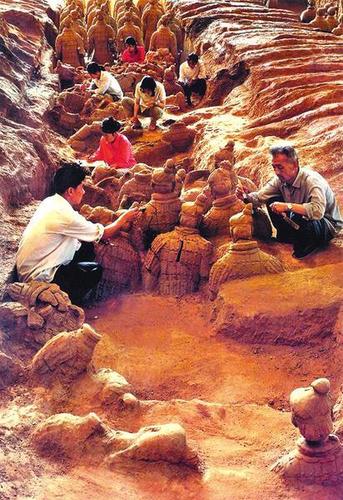
How Long Did It Take to Excavate the Terracotta Army?
The Discovery and Initial Excavation
The Terracotta Army, an awe-inspiring collection of life-sized terracotta sculptures depicting the armies of Qin Shi Huang, the first Emperor of China, was discovered in 1974 by farmers digging a well near Xi'an, China. This chance discovery unveiled one of the most significant archaeological finds of the 20th century and immediately sparked immense interest and further excavation.
The Ten-Year Excavation of Pit 1
The excavation of the Terracotta Army was a massive undertaking, particularly focusing on "No. 1 Pit," the largest of the three primary pits containing these fascinating figures. This excavation alone spanned a decade, starting from its initial discovery in 1974 and continuing until 1984. The sheer scale of Pit 1, estimated to hold over 6,000 figures, necessitated this lengthy and meticulous process.
The Process and Challenges of Excavation
Unearthing the Terracotta Army was not simply a matter of digging and lifting. The figures were buried in carefully arranged rows, surrounded by layers of earth and other materials, all designed to protect them for the afterlife. Archaeologists and conservators had to meticulously document, excavate, and preserve each figure and artifact found. This involved careful removal of the surrounding soil, stabilization of the fragile terracotta, and piece-by-piece reconstruction, as many figures had shattered over the centuries.
The Other Pits and the Abandoned Fourth Pit
Beyond Pit 1, two other major pits (Pit 2 and Pit 3) were also discovered, containing cavalry, chariots, and other military formations. While these pits were smaller than Pit 1, they presented their own excavation challenges and extended the overall timeframe of uncovering the Terracotta Army. Interestingly, a fourth pit was discovered early in the excavation process, but it was found to be empty. This discovery led archaeologists to believe that the burial project for Qin Shi Huang was abandoned before its completion, leaving a tantalizing mystery about what this fourth pit might have contained.
Continuing Excavation and Ongoing Research
While the main excavation of the three primary pits took over a decade, work at the Terracotta Army site continues to this day. Archaeologists and researchers are still excavating, preserving, and studying this vast complex, constantly making new discoveries that shed light on the reign of Qin Shi Huang, ancient Chinese military practices, and the artistry of the period. The Terracotta Army remains an active archaeological site, with the potential to reveal even more secrets for generations to come.
FAQs
How many Terracotta Army figures have been excavated?
Approximately 2,000 Terracotta Army figures have been excavated and assembled, but thousands more remain buried in the pits.
Why was the Terracotta Army built?
The Terracotta Army was built to accompany Qin Shi Huang, the first emperor of China, in the afterlife, serving as his symbolic guardians and protectors for eternity.
Are the Terracotta Army figures all unique?
Yes, the Terracotta Army figures are astonishingly lifelike and unique. Each figure has distinct facial features, hairstyles, armor, and poses, showcasing the incredible skill and artistry of the craftspeople who created them.